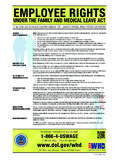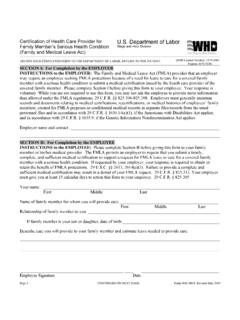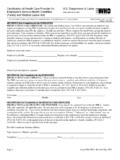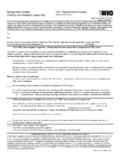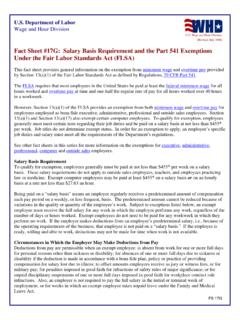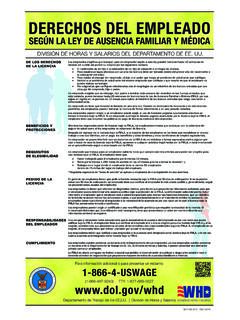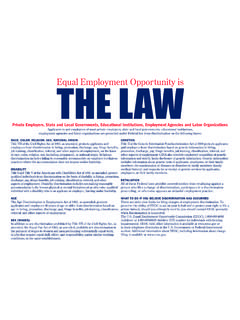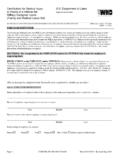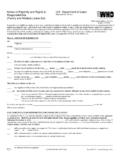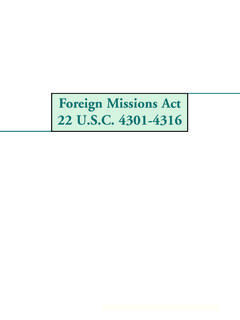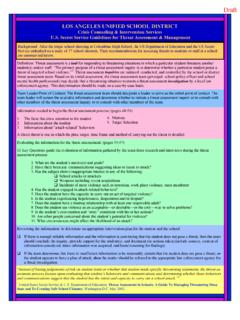Transcription of Professionalism - United States Department of Labor
1 Skills to Pay the Bills Professionalism Throughout our working lives, most of us will have many different jobs, each requiring a different level or set of skills. No matter the industry from customer service to an office job to construction and the trades all of these jobs have one thing in common: in order to succeed and move ahead, you need to demonstrate Professionalism . Professionalism does not mean wearing a suit or carrying a briefcase; rather, it means conducting oneself with responsibility, integrity, accountability, and excellence. It means communicating effectively and appropriately and always finding a way to be productive.
2 Employers want new workers to As today's Labor market becomes more and more competitive, be responsible, ethical, and team jobseekers will need to continually find ways to stand out from the oriented, and to possess strong crowd. There are few things an employer values more than communication, interpersonal, employees who carry out their duties in a professional manner. and problem solving skills. Wrap these skills up all together and Professionalism isn't one thing; it's a combination of qualities. A. you've got Professionalism . professional employee arrives on time for work and manages time effectively.
3 Professional workers take responsibility for their own behavior and work effectively with others. High quality work standards, honesty, and integrity are also part of the package. Professional employees look clean and neat and dress appropriately for the job. Communicating effectively and appropriately for the workplace is also an essential part of Professionalism . Regardless of the job or industry, Professionalism is easy to spot. On a construction site or in a trade, a professional worker will work hard and manage time effectively, including arriving and returning on time from breaks. A professional worker in a customer service setting will speak clearly and politely to customers and colleagues and have neat and clean appearance.
4 In an office setting, an employee with Professionalism will work productively with others and strive for a high standard and constant improvement. Professionalism may look slightly different in various settings, but the core elements are always the same and give young employees an edge as they begin their careers. The activities in this section focus on each of the five individual soft skills presented in this publication (communication, enthusiasm/attitude, teamwork, networking, and problem solving/critical thinking), but in a broader framework. This is because Professionalism , in and of itself, is not one skill but the blending and integration of a variety of skills.
5 When Professionalism is demonstrated, it tends to be thought of as the entire package. 114. Mastering Soft Skills for Workplace Success A note to facilitators: Professionalism is not an easy skill to develop, since it is the make-up of many different skills all mushed together and tends to take years of experience to perfect. More than any of the other soft skills covered in this publication, Professionalism is the one that employers (and others) say they know it when they see it. Recognizing that there is a population of young people who may struggle with one or more of the individual skills that make up Professionalism , it is important to provide a safe environment for all youth who are determined to practice and reinforce these skills.
6 Young people need an environment where they feel safe enough to make mistakes, learn from their mistakes, and have opportunities (and the encouragement) to try again. It is by offering a safe environment along with encouragement that all youth can succeed and develop their own personal style of Professionalism . 115. Skills to Pay the Bills 26. Professionalism in Today's Workforce JUST THE FACTS: The face of the workplace is constantly evolving as one generation begins to retire and another moves up to take its place. In 2010, an office may have a mix of baby boomers (and older), Gen X-ers, and Gen Y-ers (Millennials) all working together.
7 In addition to generational differences, differences in education, upbringing, social norms, and values may create cultural gaps that may lead to misunderstandings or conflicts at times. In reality, a variety of perspectives in the workplace can actually benefit and strengthen an organization. The purpose of this activity is to have participants discuss how to bridge generational, cultural, and other diversity gaps in order to build a new standard for Professionalism in the workplace. Time 30 minutes Materials Optional: Flip chart/markers Activity 26 (The Cultural Divide). Directions Today's workforce is made up of people from many different generations.
8 In fact, some workplaces include people ranging in age from 16 to 70 (or older) all working together. How can these different generations of workers all get along when so often their values, ideas, and experiences are so different? Begin a discussion around something like: What do you think the older generation thinks of the younger generation? [Examples may include: lazy, lack of loyalty and respect, need for constant feedback, unrealistic (expect to get to the top right away)]. What does your generation think of the older generations? [Examples may include: inflexible, slow, set in their ways, technologically incompetent].
9 Do you think these ideas are always true? Sometimes true? Never true? Why do you think each group may have these ideas about the other group? Discuss the word stereotype. Use the following for discussion or use a definition from another source: According to the online Urban Dictionary, a stereotype is used to categorize a group of people. When we stereotype groups of people, we depict all people within that group as having the same characteristics. What causes these stereotypes? How can our society rid itself from grouping people by stereotypes? 116. Mastering Soft Skills for Workplace Success Divide the larger group into groups of no more than four.
10 Each group will be using Activity 26 to discuss some of the situations that might create a cultural divide in the workplace. Discuss the small group answers as a larger group. Conclusion Draw out a list of some of the strategies one can use on the job to ensure that everybody works well together (not just different generations). Discuss some of the proactive steps one might take to ensure stereotyping does not occur on the job. Some examples might include: Look past stereotypes Find common ground Learn from each other Listen to each other Acknowledge and appreciate differences Promote intergenerational discussions Journaling Activity Think about a time when someone made a biased judgment about you or acted unfairly toward you because of your age, skin color, clothes you were wearing, gender, the way you speak, where you live, how much money your family has, or some other reason.
